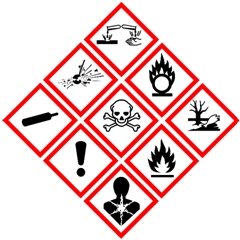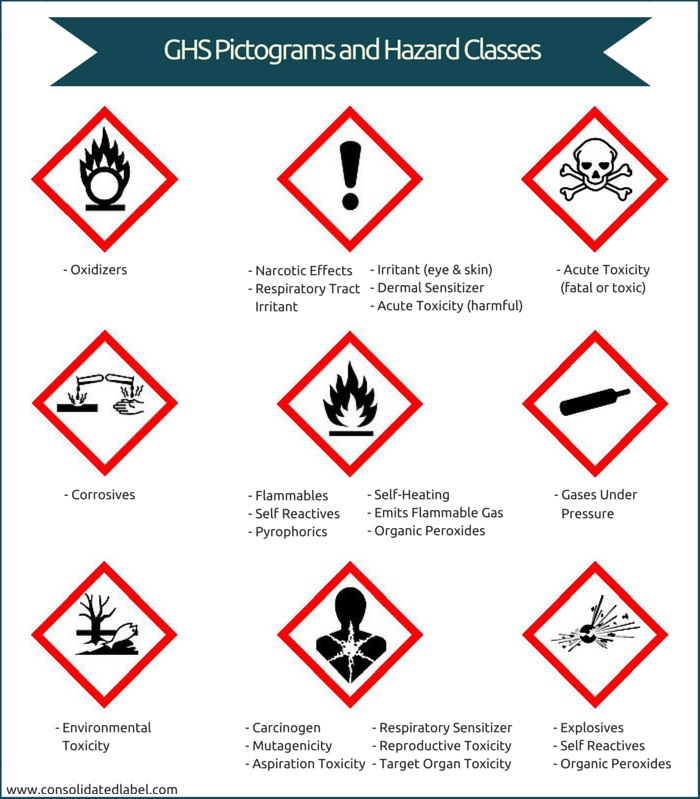
If your business deals with hazardous chemicals, then you’ve probably heard someone mention the Globally Harmonized System of Classification and Labeling of Chemicals, aka “GHS.” If you’re not quite up to speed with the latest and greatest system in chemical labeling and you need GHS compliant labels, we’re going to cover the basics to help you better understand GHS compliant labeling. This article is for you if you’ve ever wondered:
- What is GHS? And why was it developed?
- Who does GHS affect?
- How do I design GHS compliant labels?
- What types of label materials should I use?
The Story Behind GHS
GHS was created from an international mandate by the United Nations in 1992. Ten years later, the first edition of GHS was adopted (December 2002) and has been updated every two years since. According to the U.S. Occupational Safety & Health Administration’s website, “The GHS is a system for standardizing and harmonizing the classification and labeling of chemicals. It is a logical and comprehensive approach to:
- Defining health, physical and environmental hazards of chemicals;
- Creating classification processes that use available data on chemicals for comparison with the defined hazard criteria; and
- Communicating hazard information, as well as protective measures, on labels and Safety Data Sheets (SDS).”
As stated, GHS is NOT a regulation or a standard. It’s a system that regulatory bodies can use to develop or modify existing national programs to address:
- Classification of hazardous chemicals.
- Transmittal of information about those hazards.
- And protective measures that cover a chemical’s life cycle to promote safety to all who are potentially exposed (workers, consumers, emergency responders and the public).
Who Does GHS Affect?
Chemical manufacturers, importers, distributors, employers and regulatory bodies have all been impacted by the GHS system. In the United States, we have the Consumer Product Safety Commission (CPSC), Department of Transportation (DOT), Environmental Protection Agency (EPA) and the Occupational Safety & Health Administration (OSHA) that each have requirements for classifying and labeling hazardous chemicals.
The requirements vary since they cover different sectors like transport, workplace, consumer goods, and pesticides. Currently, their hazard communications are based on parts of the GHS system most relevant to their sector(s). Multinational companies face the added challenges of regulations from foreign agencies, as well as the United States, which helps explain why classifying and labeling chemicals can be a costly, complex and time consuming task.
That’s why GHS was created – to make it easier for companies to classify and communicate hazardous chemicals through consistent information on their labels and safety data sheets, while promoting safety to all who are potentially exposed.
Employer Deadline
In 2012, OSHA made a final ruling that its Hazard Communication Standard would conform to GHS. The deadline for U.S. manufacturers and distributors to comply with the new standards was June 1, 2015. Employers must be fully compliant by June 1, 2016 with workplace labeling and new/updated hazard communications, along with additional employee training, if needed. Click to learn more about OSHA’s guide to GHS.

Elements Of A GHS Compliant Label
GHS doesn’t have a required, standardized label format, but there are required label elements. Featured right is a sample label from OSHA. GHS labels should include:
- Signal words: Indicates the relative severity level of the hazard. “Danger” and “Warning” are often used – the former for more severe hazard categories. Each category has assigned signal words.
- Symbols/Pictograms: Each GHS hazard class and category* has a pictogram to convey health, physical and environmental hazard information. Hazardous pictograms have a black symbol with a white background centered in a red diamond frame. See below for pictograms.
- Hazard Statements: Standard phrases assigned to a hazard class and category that describe the nature of the hazard, and when appropriate, includes the degree of the hazard.
- Precautionary Statements & Pictograms: States measures to minimize or prevent adverse effects from physical, health or environmental hazards. First aid is included in the precautionary statements.
- Product Identifier (Ingredient Disclosure): The name or number used to identify a hazardous product; mixtures should also list hazardous ingredients. The product identifier on a label and safety data sheet should match. If a substance or mixture is covered by the UN Model Regulations for Transport of Dangerous Goods, the UN proper shipping name should also appear on the package.
- Supplier Identification: The name, address and telephone number of the manufacturer or supplier of the product.
- Supplemental Information (optional): GHS allows the option to provide additional information on labels like hazards that haven’t yet been incorporated into the GHS or additional supplier information. Supplemental information isn’t required or specified under GHS, but when used, can’t contradict or cast doubt on validity of hazard information.
*Hazard class means the nature of the physical, health or environmental hazard like flammable solid carcinogen, oral acute toxicity. Hazard classes are listed in the bullet points in the graphic below.
Hazard category is used to describe sub-sections of classes. Categories are assigned a number (1, 2, 3…) with category 1 being the most hazardous. For example, oral acute toxicity includes five hazard categories ranging from “fatal” to “may be harmful.” Categories only compare hazard severity for their class – not across all total categories.

Suggested Label Materials
When it comes to materials for GHS labels, durability is key. Our suppliers have their materials tested through a third-party facility to ensure the materials meet recognized standards for durability and environmental resistance. Any ink will work for GHS, however, we recommend that the ink and label are tested for your specific application environment to ensure they meet your needs. We have several recommendations for label materials which we have ready to go in our inventory.
- Semi-gloss paper: A bright white paper with exceptional ink receptivity and high internal strength characteristics. We suggest using a laminate finish to add an extra measure of protection against the label’s environment.
- White polypropylene film: Extremely durable and can be used for short term outdoor use. White film typically maintains its quality against moisture and other conditions better than paper but has a higher cost per label.
- Thermal transfer paper: A cost-effective white paper material that is popular for barcode applications. Unlike direct thermal paper, this material can endure heat or sunlight, and can be printed in colors other than black. Thermal transfer paper is a good option for labeling shipping or inventory boxes.
There are more options available, and we can order a special material if we don’t have it readily available (lead times can vary). For example, labels for drums require special considerations, so let our customer service reps know exactly what you’re labeling to ensure you’re matched to the right material. A customer service rep would be happy to go over those materials with you.


